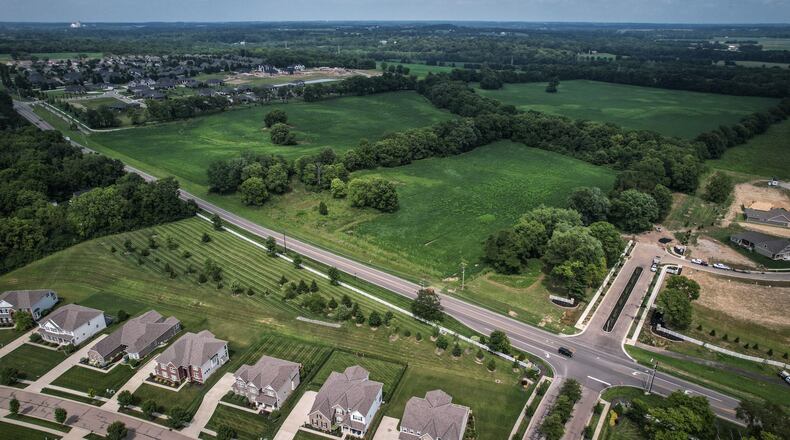Stonehill Village is by far the township’s largest residential development, and it claims to be the largest master planned community in Southwest Ohio.
“Over a decade, this will get built out,” said Max McConnell, economic development and zoning administrator for Beavercreek Twp. “That is the expectation we have, that these — especially the ones we’re approving now — will fill up over the course of 5-10 years, rather than two to five.”
Located on either side of Trebein Road, and bounded by Hilltop Road to the east, the development was first set aside for residential homes in 1993, and later revised in 2016. After some homes were built were built early on, construction took off again in the second half of last decade.
While the first houses were built in the early 2000′s, housing construction took off in the second half of the last decade.
McConnell said current market forces are catching up with planning that happened 30 years ago,
The township has approved eight applications from multiple developers to build 980 single-family residences and an additional 246 multi-family units across as many subdivisions. Of those, just under 600 homes have actually been constructed.
One subdivision, called the Courtyards at Stonehill Village, began construction last year. Developer Artisan Communities, a subsidiary of Dublin, Ohio-based Epcon Communities, held its grand opening Thursday, in a neighborhood that has an expected 162 luxury ranch-style homes, built over three phases. Artisan Communities President Dan Armbruster said he estimates the first residents will move in as soon as six months from now.
“Stonehill Village is a special place. It’s going to stay that way,” Armbruster said. “We’re proud to be here and we’re going to build a nice community here.”
Artisan Communities’ target market is homeowners 55 and older, Armbruster said, who are seeking to downsize in their empty-nester years, but who still want high-quality, luxury homes and amenities.
“They want to be close to shopping, the doctors, all the people that service them,” Armbruster said. “People can sell their larger homes, and move into (something) maintenance-free, all on one level. So there’s a huge demand for that.”
Housing prices at the Courtyards start at $400,000, but many are priced around the $550,000 mark, Armbruster said.
Housing industry analysts say the Dayton area has too few homes for sale, with realtor.com this spring ranking the region fourth-worst in the nation for the year-over-year change in number of homes for sale.
John Morris, executive director of the Home Builders Association of Dayton recently said the region will struggle to attract new business if there aren’t enough places for workers to live.
McConnell said Beavercreek Twp.’s balance of rural character, right on the edge of more urban areas, makes the township popular for housing developments. Much of the land in Stonehill Village had previously been in agricultural use, owned and managed by Nutter Enterprises, LLC.
Other forces like the Honda battery plant coming to neighboring Fayette County, as well as the continuing personnel demands of Wright-Patterson Air Force Base, have pushed developers to seek out the land for housing, McConnell said.
“On the community development side, we’re thinking about the challenges (of new residences), but on the economic development side, we are thinking about it positions Beavercreek Twp. to benefit from the kind of new employment opportunities from something like the Honda plant,” McConnell said.
At just under two square miles, Stonehill can have a maximum of 1,835 housing units, and of those, more than 1,300 must be single-family homes and 512 can be condos, apartments, or other multi-family units, per Beavercreek Twp. zoning.
A ninth neighborhood, Crown Point Estates at Stonehill Village, has been proposed northeast of the intersection between Trebein Road and Dayton-Xenia Road, east of Jacob Coy Middle School. Developer Kerwn Gold submitted a pre-development concept plan to Greene County Regional Planning in May, proposing 287 residential units across the 38-acre parcel. The developer must submit plans to Beavercreek Twp. zoning officials before being approved by Regional Planning, Greene County officials said.
Growth already prompted the township to construct another fire station in 2021, at the intersection of Trebein Road and Fairground Road, giving firefighters easier access to the surrounding residential developments.
The ongoing $40 million upgrade to the U.S. 35, Trebein and Valley Road intersection will include a new bridge over U.S. 35, that will carry northbound and southbound traffic between Trebein and Valley roads.
The new full highway interchange will replace the current four-way traffic light that governs between 12,000 and 14,000 vehicles per day, often with congestion causing backups in multiple directions.
Beavercreek City Schools continue to adjust to growth in the community as well, now educating just shy of 8,000 students.
Classroom space in Beavercreek Schools is at a premium, district officials said, particularly in the elementary schools. As more families continue to move to the area, those new students will also require more teachers, technology, buses, and equipment.
During the 2020-2021 school year, the district added a portable structure with six classroom spaces outside of Trebein Elementary School, and opened additional portable classrooms of the same size at Main Elementary School and Fairbrook Elementary School in the fall of 2022.
“Ultimately, the greatest need we see is staffing and space,” district Superintendent Paul Otten said.
The school district will have a tax levy on the ballot this November, seeking replacement of an existing permanent improvement (facilities) levy, originally passed by voters in 1989. The existing one-mill levy collects approximately $920,000. The new levy would collect approximately $2,175,000 at current property valuations if approved, officials said.
The money will “more closely cover today’s cost” to maintain the district’s facilities, upgrade equipment and will be used to replace an aging bus fleet, Otten said.
About the Author




